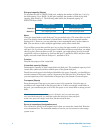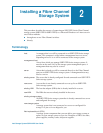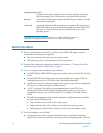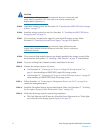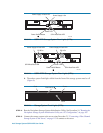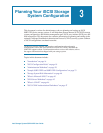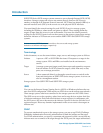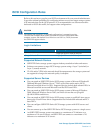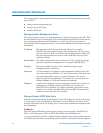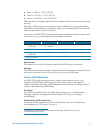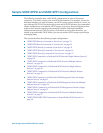
16 Intel Storage System SSR212PP User Guide
Revision 1.0
PRELIMINARY
Introduction
SSR212PP-Series iSCSI storage systems connect to servers through Internet SCSI (iSCSI)
interfaces. Storage systems and servers can connect directly from one iSCSI port to
another, or through an IP (Internet Protocol) network. iSCSI host bus adapters (HBAs) or
network interface cards (NICs) in the servers act as the physical iSCSI interfaces.
You must identify the network settings for each iSCSI I/O port in a storage system,
including the IP address, subnet mask, and gateway address. These settings define the
targets of input from the servers in your environment. You must also identify network
settings for the iSCSI I/O ports in servers that connect to the storage system; these settings
define the initiators of I/O between servers and the SSR212PP2i and SSR212PPi storage
systems.
In some contexts, iSCSI documentation refers to the servers and storage systems
themselves as initiators and targets, respectively.
Terminology
In this document, we use the terms initiator, target, server, and storage system as follows:
Initiator A port on a NIC or iSCSI HBA that issues I/O requests to a target in the
storage system. NICs and HBAs are installed on the environment s
servers.
Target A storage system port (target portal) that accepts and responds to requests
from an initiator. In iSCSI systems the targets, called front-end, or data,
ports, are on storage processors.
Server A host connected (directly or through a network router or switch) to the
front-end (data) ports on SSR212PP-Series storage systems. A server can
also be a management station.
Storage system Your SSR212PP2i and SSR212PPi storage system.
iSNS
You can use the Internet Storage Naming Service (iSNS) on Windows platforms that are
part of an iSCSI configuration. iSNS requires an iSNS server on the storage network and a
client storage system; other hosts connected to the storage system are also iSNS clients.
The iSNS server acts as the repository where hosts and storage devices register their lists
of initiators and targets. Each individual initiator or target registers its components with
the iSNS server; the server then answers the initiator s queries for devices with the list of
registered targets. Discovery domains implemented on the server restrict what targets an
initiator sees.
CHAP
To prevent unauthorized access to the storage system, you can set up CHAP (Challenge
Handshake Authentication Protocol) authentication for both the initiator and the target.
For CHAP authentication, you specify a username and password (called a secret) that any
initiator must use to connect to the target through the iSCSI ports; the target authenticates



